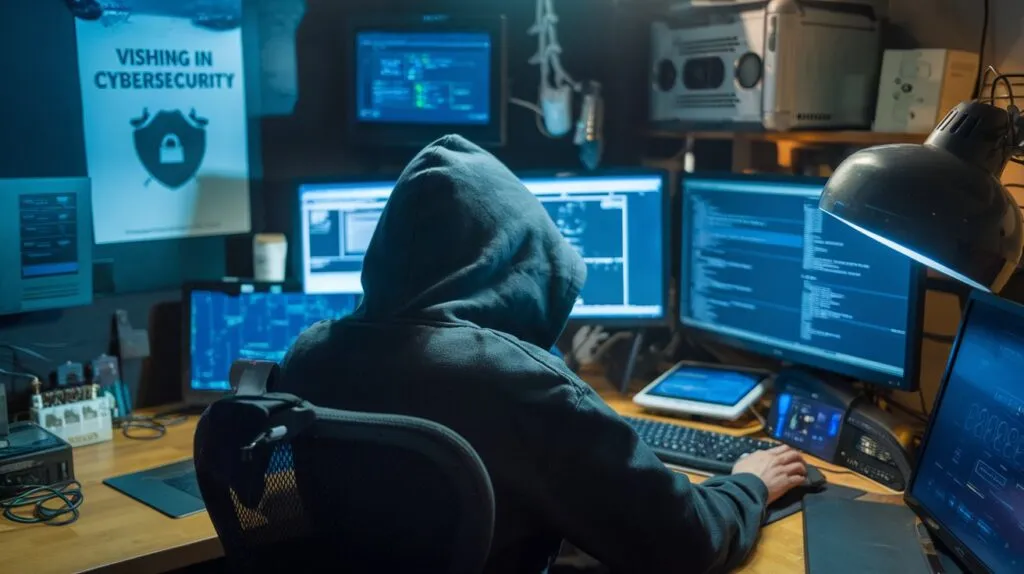What is Vishing in Cybersecurity?
Vishing, created by placing a combination of “voice” and “phishing,” is the threat where the attacker calls a person or leaves a voice message with the intention of the person sharing login credentials, account numbers, passwords, or other sensitive information. Differently from the other cybercrimes that employ weaknesses in systems software, vishing attacks users psychology which makes it a very dangerous type of social engineering.

How Vishing Works
- Vishing exploits deceptive communication techniques to cause victims to do things. Often attackers mimic trusted organizations, like banks, government organizations, or technical support teams, to induce false sense of urgency or authority. Here’s how a typical vishing attack unfolds:
- Spoofing Caller ID: Because scammers use spoofing tools to make their phone number appear real, it may show up as the number from a well known institution.
- Building Trust or Fear: In the scenario it’s up to the attacker, whether is adopting a friendly or an authoritative tone in order to manipulate victim’s emotion.
- Requesting Sensitive Information: It is where the caller calls the victim and encourages him to share the private information such as account numbers PINs and verification codes in the guise of fixing the problem or even to avoid a fraud.
For instance, you may be called and said your credit card has been compromised. In some cases, they may ask for verification details such as your card number or security code, just to ‘secure’ your account. What is actually being done with this information is unauthorized transactions.
Common Vishing Scenarios
- Banking Scams: Attackers call themselves bank representatives contact you claiming there’s suspicious activity on your account.
- Tech Support Fraud: Impersonating IT support they have warn of malware infection in order to steal remote access to your device for phoney solutions.
- Government Impersonation: Whatever IT support impersonates them warning of a malware infection in order to steal remote access from your device for fake solutions – Relying on hackers to protect yourself is a fool’s game, as promised.
- Voicemail Traps: Such pre-recorded messages urge recipients to call back under some false pretext and have high pressure tactics once they respond.
Why Vishing is Effective
- Exploiting Emotions: Fear is so real, urgency is so urgent, trust that it runs deep. Under emotional stress victims are often impulsive and irrational.
- Lack of Awareness: vishing tactics now become easy targets for many individuals, nor businesses are aware of when they become aware, it is easy.
- Minimal Digital Trace: Unlike email phishing, phone-based attacks leave fewer digital breadcrumbs, making them harder to trace and block.
Real-Life Examples of Vishing
An infamous example had attackers posing as a company’s CEO, talking an employee into wire $200,000 to a scam account. In a different case, vishing was used to access personal bank accounts by scammers and result in substantial financial damage to the victims.
How to Protect Against Vishing
For Individuals:
- Verify the Caller: If you receive a phone call from someone that you don’t know, hang up and contact the organization using their official number.
- Avoid Sharing Sensitive Information: Never give away passwords, codes, or PINs over the phone. These details do not ask for from legitimate organizations.
- Stay Calm: They create an urgency to befuddle judgment. Be careful about what you say, take your time to think critically in responding.
- Use Call Filtering Tools: Leverage smartphone features or apps that block or screen spam calls.

For Businesses:
- Employee Training: Educate staff about vising threats in regular self awareness sessions.
- Verification Protocols: Verify requests strictly and always for financial transactions.
- Incident Reporting: That’s important as it encourages employees to report suspicious calls quickly in order to prevent further attacks.
The Role of Technology in Vishing
For the most part, traditional vishing relies on simple phone calls, but nowadays techniques even use AI driven tools and deepfake voice technologies. That makes it easier for attackers to spoof voices, and thus more successful.
Conclusion
Vishing is a vector of choice cybersecurity challenge that exploits human vulnerability instead of technological flaws. Talent can understand how vishing works and takes practical steps to reduce the risks to themselves and their organizations. Be vigilant, educate yourself and others, check before you trust: you’re best on the defensive in this world of cybersecurity!



